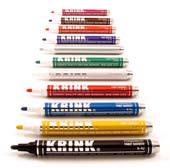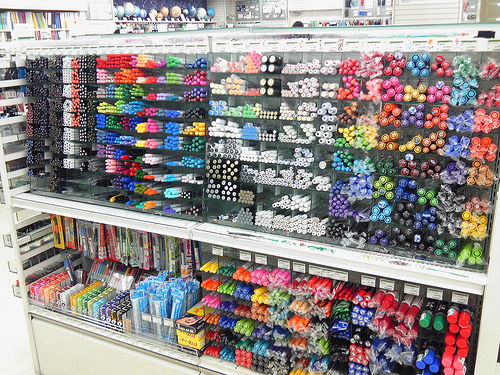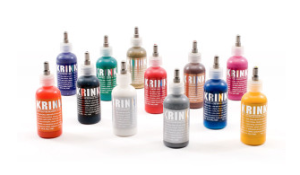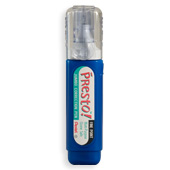
When it comes to graffiti paint markers, there are tons of options available to you. Before you invest in a paint pen, know where you’ll be using them – what surfaces? What color backgrounds? How strong is the buff in your city?
Your Graffiti Paint Marker Options
- Steel tips are great for thin lines, drips and painting on rough surfaces. Steel tip graffiti markers are often filled with thick paint.
- White out pens are a miniature version of the steel tip paint pens and are great for smaller areas, and if you want a super thin line, and let you drip out your tags when moving slowly.
- Felt tip markers are great for thick lines, large tags and do best on smooth surfaces. Felt tip markers are a typical graffiti paint pen, and are the most commonly used.
- Mop markers are great for big, dripping tags on smooth surfaces. Mops are squeezable and allow you to release as many drips as you want.

When your local graffiti shop looks like this, you need to know what you’re looking for.
Steel Tip Paint Markers

They present a thin line, and are often squeezable making them insanely easy to drip (in fact, it takes good marker control to not drip).
The Good: Steel tips work excellently on rough surfaces like concrete. Great if you’re into thin lines and lots of drips.
The Bad: This is the wrong marker if you want big thick lines, or need to be silent while throwing your tag. Lid is sometimes prone to leaking.
White Out Pens

Now, they are a common weapon in most graffiti artists’ arsenals.
White out markers are great for small tags on fairly smooth surfaces. They easily fit in your pocket and are easy to get ahold of. White out markers are common school/office supplies, so – unless caught in the act – shouldn’t draw too much attention if you get stopped with one in your pocket.
Since the line is so thin, the pen seems to last a long time.
The Good: White out markers are great for thin lines and hard to get places. Great for finding a small spot that the buff won’t reach. Absolutely no issue if the cops catch up with you carrying one of these. Lasts a long time.
The Bad: Not very durable, and fairly easy to buff. Terrible if you want to throw large tags or have a ton of drips.
Felt Tip Paint Markers

These paint pens seem to last a long time because the felt tip regulates the amount of paint to come out. With pump-action felt tip markers you will have the ability to drip your tags, but in general felt tips are harder to drip than a steel tip or a mop.
They come in chisel tip and a broad tip (meaning rounded), so depending on the style of your tag, you might want to make sure you’re buying the right pen (or learn how to cut/customize your own nip).
If you are using on concrete (unless polished), your felt tip will get eaten up and torn to shreds.
The Good: Great for silent use, and indoor tags. Perfect for consistent widths on your lines, and if you want a clean tag with minimal drips. Often these are refillable (same colour), and come with sturdy lids that won’t leak.
The Bad: Performs terribly on rough surfaces. Tips can feel rigid and not leave great when you first use the pen. In general, felt tips are fairly easy to buff.
Mop Markers

Mops really excel when you use them on smooth surfaces like doors or other smooth metals. The paint being squeezed out will allow your mop to glide over the surface (and drip!) easily. Since most mops use sponge or hairy tips, when used on a rough surface like concrete they will fall apart or – in cheaper models – the lid will pop off.
Mops are known to be messy, since there’s rarely any regulator stopping the paint from coming through the tip. If you don’t have a good cap/lid (most don’t) and your mop tips over in your bag, car, or pocket you can expect to have a long and permanent clean up ahead of you.
The Good: Great for large tags on smooth surfaces. Great for drips, and silent tagging.
The Bad: Not a great pen for beginners and toys as the drips can be hard to control. Mops seem to really burn through ink/paint. Tip will be torn apart if used on a rough surface. Mops can be messy.
So What’s The Best Paint Pen?
There’s a lot to think about when it comes to paint pens, so how do you know what one to buy? Start by reading some of the helpful resources we have on this site:
- Here’s our review of the Best Graffiti Markers
- Here’s a great Krink K-71 Review
If you’re still wondering about something, don’t stop there. Write any questions you have in the comments and I’ll help you out.
I personally respond to each comment, so ask your question (or just say hi!) and I’ll get back to you.

I will be writing short sentences on building sides. I don’t need dripping or flashy colours, but I do need to be quiet and quick. What would you suggest?
Hi Mr. Satirical Taunt, I’m going to riff on a few different aspects.
For writing sentences I’m guessing your letters are typical graffiti tag size, meaning each letter is going to be – at most – 2 meters / 6 feet tall?
In that sense, spray paint is a great medium. Use a name brand spray paint (Montana, Molotow, Belton, 94, Hardcore, Ironlak) and buy a few caps. Assume 2 caps per piece on average, bring 5 out with you. Whites and Blacks are always good, yellow typically lays down the weakest.
If you’re buying the dog shit Home Depot brand spray paint, just go with black or red. No whites, or yellows. Gold, silver, or light blues/greens will all be risky purchases.
You can either be quiet, or you can be quick… but you can’t be both. Noise is typically less important than it seems. Getting over the discomfort of doing something illegal and making noise is part of creating a piece of art you’re proud of. Using a “skinny” or “thin” cap will be quieter and easier to manage your lines, the trade off being that it’s much slower than it’s counter-part the more popular fat cap. You sacrifice noise for a much broader, more readable line.
There are arguments for each… On one hand, you’re using a pretty efficient tool for writing big letters, so maybe a skinny cap is enough. On the other, you’re only spending 5 minutes painting, and then it’s done… so why not do it bigger, bolder, more in your face, faster? Hope this helps.
A felt tip
Hello my name is XZET and watch out or I might tag ur house when u sleep ehehehhe
i love drawing graffiti in my sketchbook, i’m a coward about going out and tagging things. lol. my favorite markers to use to fill in my drawings are sharpies because of their vibrant colours. my only problem is the ink bleeds past the outlines i have drawn making my artwork look sloppy. is there any way i can avoid this or at least lessen this problem?
Buy paint markers in the colors you like to outline with and draw the very first outline with the color of your fill and do the outline lsat
I don’t use sharpies but I’m sure that buying a pad with paper made specifically for markers will alleviate the problem. That is what i use and there is no bleeding with my markers.
If you don’t already use Sharpie paint markers, you should (can be found on websites like Amazon.com or any art store. But, if you do, then you should get a pad meant SPECIFICALLY for markers.
I suggest using a paint marker as an outline marker, like the molotow one4all acrylic twins. It works perfectly for me! No bleeding through my outlines.
I’m doing a project for art and was planning on using a sheet of metal, but I was wondering what pen would be the best and most permanent option to use? Because the metal is relatively smooth, sharpies just wipe off.
I want to tag walls,desks,and windows and i need a marker that’s good for thick lines and smooth drawings. i saw that felt tips are the best,what brand is best for that?
depends on your price range and line thickness if you need a cheap thick line use a sharpie paint pen bold nib or a Montana is an expensive thick one the markers i started with is the normal paint sharpies or decos
Hey i need an good recipie for graffiti paint based ink. it could be nice if i could do it with acrilyc paint and thin it with washing benzine or something but i need something that stains really hard but i dont have brake fluid at home.
@Sam Londero If you’re willing to pay a few bucks, Grog makes a booster additive for the street killer ink.
Here’s the product from grog’s website, maybe you can find it at your local graff store or order online.
http://www.grog.eu/grog-booster-08-ski
What are good markers for a beginner looking at practicing in a sketch book?? If you have links for packs then please let me know!
Cheers.
What’s up Tyrell! I wrote about this a while back. Check out this article and let me know if it helps out: https://graffkit.com/best-markers-paper/
My biggest problem is finding a marker that works while working being held upright (as in holding it up to write on a wall as opposed to on a piece of paper) I’ve tried loads of brands – do you have any recommendations?
Hey Nicola, the solution is actually in your technique, not the pen. Check out this article and scroll down to the pic you see of Pink paint under the sub heading “Use gravity to your advantage by angling your mop downwards” https://graffkit.com/make-a-graffiti-mop/
If you add this slight downwards angle, you should see the markers you’re using are fine for the job. Let me know if that helps!
I need some colorful pens to write on burlap. what would suggest?
Hi there I am starting up a business of personalising fake roses bouquets with grafitti e.g. Fo a new baby big birthdays etc so would need to be thin markers to write wordings and draw small pictures what markers would u recommend so that is has that sprayed on grafitti look please
Hey Sara! if you want it to look sprayed, you’ll probably want an airbrush. Another option would be to use a stencil cap on a traditional spray paint can.
im planning on starting some pieces on canvas, can you link me some good and cheap canvases, along with some good paint markers, preferably felt tip and not a chisel tip, i prefer the rounded point
where do I find a chisel tip white out or any chisel steel tip markers? PLEASE HELP
What up PHILDEZY, the “Uni Paint PX-30” is a great chisel tip that comes in white. It’s worth taking a look at!
Hey! Great article! I have started bombing a little while ago and graffiti supply stores really too much of a thing in my country… I have been using 10-15mm felt markers with home made ink from pens and alcohol. Sadly this is very easy to buff… i would love to know what is harder to buff, paint (oil based) or ink? What inks or paints could i buy that dont just wipe off with a bit of alcohol? Or what additives should i try to put in my ink? Ive tried dot3 breakfluid (various amounts) , methylene blue but it is only available as 1% and waterbased liquid so it didnt work well… chemicals such as gentian violet and stuff like that arent easily agailable here :(( sorry for the long question thanks in advance!
i saw a tag that had this radiant color changing pattern done with one stroke .. i know its a paint based mop because the lines are decent .. but then again there was no drip .. can you gelp
I am new to this and quiet and tame (at least to outer appearances and most behaviors). What is the best for simple 2-inch high letters on rough surfaces?
I found out by experience (with no previous experience beyond restrrom stall doors in fine point) that wide permanent markers and paint markers just don’t work that well.
If you love science fiction I will tell you my inspiration.
No spray paint or “big art” stuff is needed for this.
I wish to write short pieces on benches (usually wood, plastic or maybe MDF slats), concrete bridge columns, building sides.
Sentences you say? Or words and such? No dtipoing….I would just go with a Magnum fathead.
Hi. For doing tags and small scale pieces what would be better? Ink pens or paint pens? Would appreciate pros and cons of both a lot! I’ve heard more about paint pens than ink pens.. so I was wondering if there’s a big difference. Thanks:P
hey man. i just wanted to say thanks your blog has helped me decide so many things, from what black-book would be best for me to the types of markers to use in it. i just have one question. whats the best way to go about buying paint cans? in store or going online?
What product removes these markers/paint etc?? I work with city agencies and removing this stuff is difficult. I don’t know if you will help me as it looks like you are assissting the graffiti artists in applying it. What you al need to do is stop writing all over public and private property!!
Eat a dick….